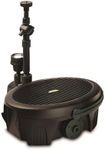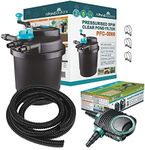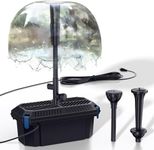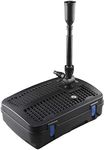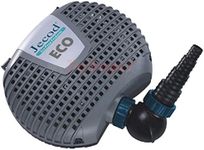Buying Guide for the Best Pond Filter Pumps
Choosing the right pond filter pump is essential for maintaining a healthy and clean pond environment. The pump helps to circulate water, ensuring that it remains oxygenated and free from debris and harmful substances. When selecting a pond filter pump, it's important to consider several key specifications to ensure that the pump meets the needs of your pond and its inhabitants. Understanding these specifications will help you make an informed decision and keep your pond in optimal condition.Flow RateFlow rate refers to the amount of water the pump can move in a given period, usually measured in gallons per hour (GPH) or liters per hour (LPH). This spec is crucial because it determines how effectively the pump can circulate and filter the pond water. For small ponds, a lower flow rate may be sufficient, while larger ponds require higher flow rates to ensure proper filtration. To choose the right flow rate, consider the size of your pond and the type of aquatic life it supports. A general rule of thumb is that the pump should circulate the entire volume of the pond at least once every two hours.
Head HeightHead height, or maximum lift, is the maximum height the pump can push water upwards. This is important if your pond setup includes waterfalls, fountains, or if the pump needs to move water to a higher elevation. Pumps with higher head heights are necessary for taller features. To determine the right head height for your needs, measure the vertical distance from the pump to the highest point the water needs to reach and choose a pump that can handle that height.
Energy EfficiencyEnergy efficiency indicates how much power the pump consumes while operating. This is important for long-term cost savings and environmental impact. Pumps with higher energy efficiency will use less electricity, reducing your utility bills. Look for pumps with energy-saving features or those that are labeled as energy-efficient. Consider how often the pump will be running and choose one that balances performance with energy consumption.
Pump TypeThere are different types of pond filter pumps, including submersible and external pumps. Submersible pumps are placed directly in the water and are generally easier to install and maintain, making them suitable for smaller ponds. External pumps are installed outside the pond and are typically more powerful and efficient, making them ideal for larger ponds or complex setups. Choose the pump type based on the size of your pond, ease of maintenance, and your specific filtration needs.
Noise LevelNoise level refers to how much sound the pump produces while operating. This is important if your pond is located in a quiet area or near living spaces where excessive noise could be disruptive. Submersible pumps tend to be quieter since they are underwater, while external pumps may produce more noise. Consider the location of your pond and your tolerance for noise when selecting a pump. If noise is a concern, look for pumps that are specifically designed to operate quietly.
Durability and MaintenanceDurability and maintenance refer to the pump's ability to withstand wear and tear and how easy it is to clean and maintain. A durable pump will have a longer lifespan and require fewer repairs. Look for pumps made from high-quality materials and those with good warranties. Consider how easy it is to access and clean the pump, as regular maintenance is essential for optimal performance. Choose a pump that balances durability with ease of maintenance to ensure long-term reliability.
